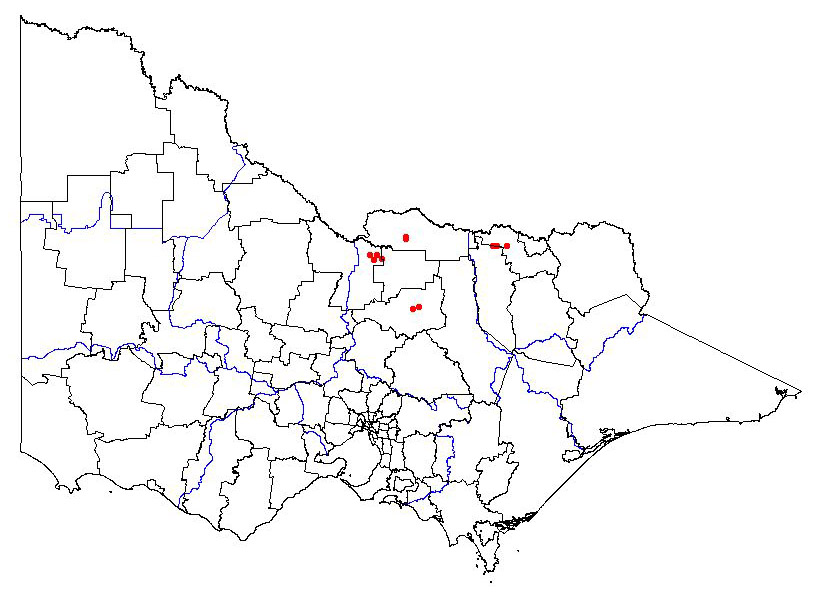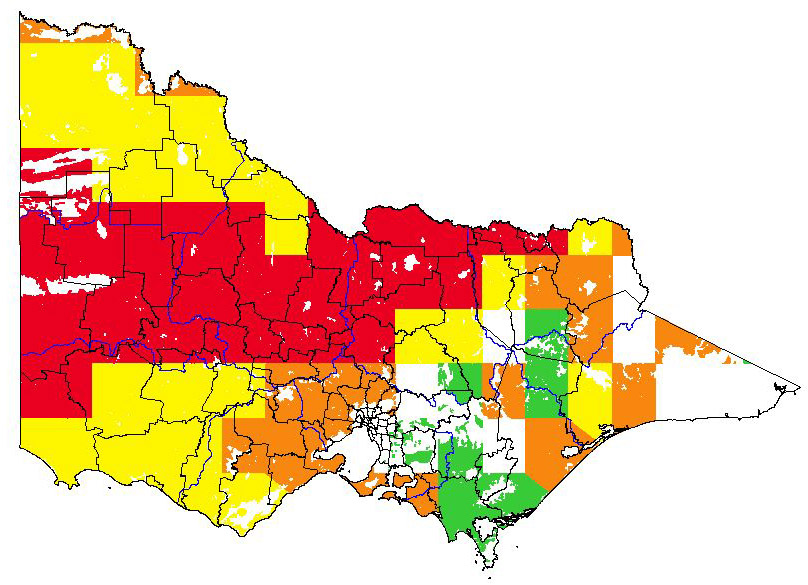Coolatai grass (Hyparrhenia hirta)
Present distribution
|  Map showing the present distribution of this weed. | ||||
| Habitat: Naturally in open and closed woodland and grassland, invades pastoral and cropping land (Grobler, Bredenkamp & Brown 2002: Lodge, McCormick & Harden 2005 and Wells etal 1986). | |||||
Potential distribution
Potential distribution produced from CLIMATE modelling refined by applying suitable landuse and vegetation type overlays with CMA boundaries
| Map Overlays Used Land Use: Broadacre cropping; pasture dryland; pasture irrigation Broad vegetation types Coastal scrubs and grassland; coastal grassy woodland; heathy woodland; lowland forest; box ironbark forest; inland slopes woodland; sedge rich woodland; dry foothills forest; montane dry woodland; sub-alpine woodland; grassland; plains grassy woodland; valley grassy forest; herb-rich woodland; sub-alpine grassy woodland; montane grassy woodland; riverine grassy woodland; rainshadow woodland; mallee; boinka-raak; mallee woodland; wimmera / mallee woodland Colours indicate possibility of Hyparrhenia hirta infesting these areas. In the non-coloured areas the plant is unlikely to establish as the climate, soil or landuse is not presently suitable. | 
|
Impact
QUESTION | COMMENTS | RATING | CONFIDENCE |
| Social | |||
| 1. Restrict human access? | Grass species with no associated prickles or sharp edges reported. | l | m |
| 2. Reduce tourism? | Grass species not easily identified. | l | m |
| 3. Injurious to people? | None reported. | l | m |
| 4. Damage to cultural sites? | No evidence of this. | l | m |
| Abiotic | |||
| 5. Impact flow? | Terrestrial species. | l | m |
| 6. Impact water quality? | Terrestrial species. | l | m |
| 7. Increase soil erosion? | Grass species used for erosion control (GRIN). | ml | m |
| 8. Reduce biomass? | Where competitive would be a direct replacement. | ml | m |
| 9. Change fire regime? | Highly flammable when dry (Wells et al 1986). Quickly grows tall and dries off (Lodge, McCormick & Harden 2005). Potential to alter seasonal pattern of fire regime. | ml | m |
| Community Habitat | |||
| 10. Impact on composition (a) high value EVC | EVC= Plains Grassland (E); CMA= Wimmera; Bioreg= Wimmera; VH CLIMATE potential. Can be a dominant species within the grass/herb layer (Grobler, Bredenkamp & Brown 2002). | m | mh |
| (b) medium value EVC | EVC= Grassy Dry Forest (D); CMA= Wimmera; Bioreg= Wimmera; VH CLIMATE potential. Can be a dominant species within the grass/herb layer (Grobler, Bredenkamp & Brown 2002). | m | mh |
| (c) low value EVC | EVC= Shrubby Woodland (LC); CMA= Wimmera; Bioreg= Wimmera; VH CLIMATE potential. Can be a dominant species within the grass/herb layer (Grobler, Bredenkamp & Brown 2002). | ml | mh |
| 11. Impact on structure? | Reported as a dominant species in the grass/herb layer (Grobler, Bredenkamp & Brown 2002). | m | mh |
| 12. Effect on threatened flora? | No evidence on specific species. | mh | l |
| Fauna | |||
| 13. Effect on threatened fauna? | No evidence on specific species. | mh | l |
| 14. Effect on non-threatened fauna? | Competes with more nutritious grass species (Lodge, McCormick & Harden 2005). | ml | mh |
| 15. Benefits fauna? | Is edible and capable of high carrying capacities for short periods of time (Lodge, McCormick & Harden 2005). | mh | mh |
| 16. Injurious to fauna? | No evidence of this. | l | m |
| Pest Animal | |||
| 17. Food source to pests? | Eaten be grazing species, which could include rabbits. | mh | m |
| 18. Provides harbor? | Can produce stands of tall dry grass (Lodge, McCormick & Harden 2005). | m | m |
| Agriculture | |||
| 19. Impact yield? | Can be managed to produce comparable yields (Lodge, McCormick & Harden 2005). | ml | m |
| 20. Impact quality? | A potential seed contaminant (Wells et al 1986). | ml | m |
| 21. Affect land value? | There is a perception of unpalatability, and low carrying capacity (Lodge, McCormick & Harden 2005). May have some impact | m | m |
| 22. Change land use? | To achieve higher carrying capacities rotational grazing for short periods of time needs to be enforced (Lodge, McCormick & Harden 2005). | ml | mh |
| 23. Increase harvest costs? | To avoid contamination extra steps would be required to be taken. | m | m |
| 24. Disease host/vector? | None reported. | l | m |
Invasive
QUESTION | COMMENTS | RATING | CONFIDENCE |
| Establishment | |||
| 1. Germination requirements? | Found to be able to germinate within a temperature range of 4-450C however at the extremes of this range, the seedlings rapidly die. Which has been used to explain the species poor survival rates when sown in autumn (McWilliam, Shanker & Knox 1970). | mh | mh |
| 2. Establishment requirements? | Present in closed woodland, tolerant of moderate shade (Grobler, Bredenkamp & Brown 2002). | mh | mh |
| 3. How much disturbance is required? | Has invaded grazed native grassland, roadsides and stock routes, encouraged by physical disturbance and burning (Lodge, McCormick & Harden 2005). | m | mh |
| Growth/Competitive | |||
| 4. Life form? | Grass | mh | h |
| 5. Allelopathic properties? | None described, competitive ability possibly more dependent on soil fertility (Jones, Griffiths Davies & Waite 1969). | l | m |
| 6. Tolerates herb pressure? | When tall and drying is avoided. Tolerant of short periods of high intensity grazing (Lodge, McCormick & Harden 2005). | mh | m |
| 7. Normal growth rate? | Competitive in that started in a trail with poor establishment and overtime made up to 40% of the cover. Out competed on more fertile soils (Jones, Griffiths Davies & Waite 1969) | mh | m |
| 8. Stress tolerance to frost, drought, w/logg, sal. etc? | Stops growing when exposed to frost, but apparently survives (Lodge, McCormick & Harden 2005). Reported to occur in all four altitude zones of venezuela, including the hot lands (drought tolerant) and the frozen lands (Frost tolerant) (Robinson & Potts 1950b). Tolerant of fire, susceptible of higher fire frequency (Jacobs & Schloeder 2002). | mh | m |
| Reproduction | |||
| 9. Reproductive system | Seed and rhizomes (Wells et al 1986). Seed production is largely through apomixis, it has not however been reported to be totally, therefore some sexual reproduction may still occur (McWilliam, Shanker & Knox 1970). | h | mh |
| 10. Number of propagules produced? | Viewed as a poor seed producer (Robinson & Potts 1950a) The potential seed output has been reported as 1940 seeds, however the average actual seed production per plant was determined as less than 200 (Jones 1968). | m | m |
| 11. Propagule longevity? | unknown | m | l |
| 12. Reproductive period? | Described as a long lived perennial grass (McWilliam, Shanker & Knox 1970). | mh | mh |
| 13. Time to reproductive maturity? | Above ground biomass senescences annually. Flowers and sets seed within first year, can also reproduce with rhizomes (Wells et al 1986) | h | mh |
| Dispersal | |||
| 14. Number of mechanisms? | Viable seed has been in baboon and ungulate scat (Slater & Toit 2002). | mh | mh |
| 15. How far do they disperse? | Unknown, deer, cattle & sheep are capable of moving kilometres. | mh | ml |
References
Fetene M. (2003) Intra- and inter-specific competition between seedling of Acacia etbaica and a perennial grass (Hyparrhenia hirta). Journal of Arid Environments. 55: 441-451.
Grobler C.H., Bredenkamp G.J. & Brown L.R (2002) Natural woodland vegetation and plant species richness of urban open spaces in Gauteng, South Africa. Koedoe. 45: 19-34.
Jacobs M.J. & Schloeder C.A. (2002) Fire frequency and species associations in perennial grasslands of south-west Ethiopia. African Journal of Ecology. 40: 1-9.
Jones R.M. (1968) Seed production of species in the Highveld secondary succession. Journal of Ecology. 56: 661-666.
Jones R.J., Griffiths Davies J. & Waite R.B. (1969) The competitive and yielding ability of some sub-tropical pasture species sown alone and in mixtures under intermittent grazing at Samford, south-eastern Queensland. Australian Journal of Experimental Agriculture and Animal Husbandry. 9: 181-191.
Lodge G.M., McCormick L.H. & Harden S. (2005) Grazing studies of a Hyparrhenia hirta (Coolatai grass) pasture in northern New South Wales. Australian Journal of Experimental Agriculture. 45: 1603-1611.
McWilliam J.R., Shanker K. & Knox R.B. (1970) Effects of Temperature and Photoperiod on Growth and Reporductive Development in Hyparrhenia hirta. Australian Journal of Agricultural Research. 21: 557-569.
Robinson B.P. & Potts R.C. (1950a) Seed setting and germination in Hyparrhenia hirta (L.) Stapf (South African bluestem) as affected by nitrogen, phosphorus, and potassium. Agronomy Journal. 42: 109-110.
Robinson B.P. & Potts R.C. (1950b) The history of Hyparrhenia hirta and studies of its flowering habits and seed production. Agronomy Journal. 42: 395-397.
Slater K. & Toit J.T.du. (2002) Seed dispersal by chacma baboons and syntopic ungulates in southern African savannas. South African Journal of Wildlife Research. 32: 75-79.
Tukel T. & Hatipoglu R. (1989) Research on the effects of different during dates and nitrogen fertilization on the yield and botanical composition of a range of vegetation dominated by Hyparrhenia hirta (L.) Stapf. In Curkurova. Doga, Turk Tarm ve Ormancik Degisi. 13: 438-449.
USDA, ARS, National Genetic Resources Program. Germplasm Resources Information Network – (GRIN) [Online Database]. National Germplasm Resources Laboratory, Beltsville, Maryland. Viewed 26 Sep 2006, http://www.ars-grin.gov/
Wells M.J., Balsinhas A.A., Joffe H., Engelbrecht V.M., Harding G. & Stirton C.H. (1986) A catalogue of problem plants in southern Africa incorporating the national weed list of southern Africa. Memoirs of the Botanical Survey of South Africa. 53: 294.
Global present distribution data references
Australian National Herbarium (ANH) 2006, Australia’s Virtual Herbarium, Australian National Herbarium, Centre for Plant Diversity and Research, viewed 27 Sep 2006, http://www.anbg.gov.au/avh/
Calflora: Information on California plants for education, research and conservation. [web application]. 2006. Berkeley, California: The Calflora Database [a non-profit organization] viewed 26 Sep 2006, http://www.calflora.org/ .
Global Biodiversity Information Facility (GBIF) 2006, Global biodiversity information facility: Prototype data portal, viewed 27 Sep 2006, http://www.gbif.org/
Missouri Botanical Gardens (MBG) 2006, w3TROPICOS, Missouri Botanical Gardens Database, viewed 27 Sep 2006, http://mobot.mobot.org/W3T/Search/vast.html
Feedback
Do you have additional information about this plant that will improve the quality of the assessment?
If so, we would value your contribution. Click on the link to go to the feedback form.


